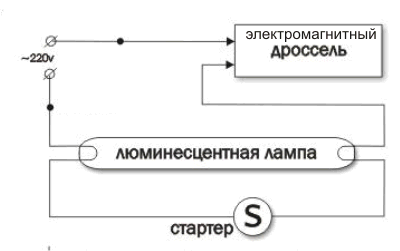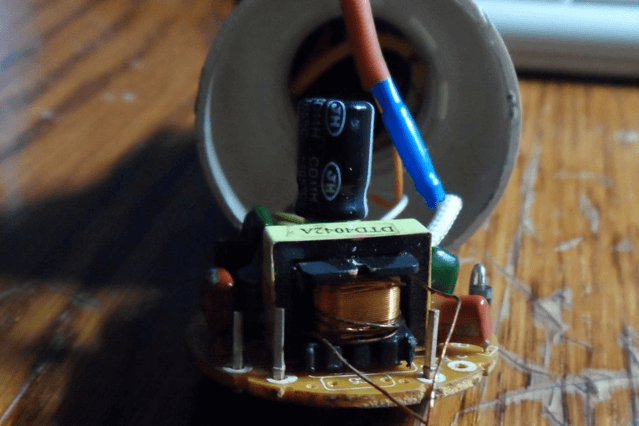What is a choke and why is it needed?
Design and principle of operation
First of all, let's talk about what this circuit element consists of and how it works. In the diagrams, the throttle designation is as follows:
The appearance of the product may be as in the photo:
This is a coil of wire wound around a core with a magnetic core, or without a case in the case of high frequencies. It looks like a transformer with only one winding. A brief excursion into physics, the current in the coil cannot instantly change. Let's conduct a thought experiment - we have an alternating current source, an oscilloscope, a choke.
During the beginning of the half wave, we observe an increase in current with a delay, this is caused by the induction of magnetic flux in the core. A gradual increase in the current in the windings occurs, when the signal goes to a drop from the AC source, we observe a drop in the current in the inductor, again with some delay, since the magnetic field in the magnetic circuit continues to push the current in the coil and cannot quickly change its direction. It turns out at some point, the current from an external source counteracts the current induced by the magnetic circuit of the inductor. In AC circuits, the purpose of the inductor is to act as a limiter or inductive resistance.
For direct current, this circuit element is not a resistance or a regulating element. This effect is used for devices in electrical circuits where it is necessary to limit the current to the desired value, while avoiding excessive bulkyness and heat generation.
You can also watch an interesting explanation on this issue in the video:
Application area
The throttle is designed to make our life brighter. Specifically, in fluorescent lamps, it limits the current through the bulb to the desired value, avoiding its excessive increase through the lamp.
The fluorescent lamp mainly consists of a throttle, a starter, a fluorescent lamp. In a nutshell, the description of the operation of a fluorescent lamp occurs as follows:
From the network, the current through the inductor passes to one of the filaments of the fluorescent lamp, then it enters the starter device, then to the second filament and goes to the network. In the starter device, the bimetal plate is heated by a glow discharge of gas, is rectified by heat and closes the circuit. At this point, the filaments begin to work, at the ends of the light bulb, heating up the mercury vapor in the bulb of the fluorescent lamp.After a short period of time, the plate in the starter cools down and returns to its original position. During a circuit break, a sharp surge in voltage occurs in the inductor, a gas breakdown occurs in the flask of the fluorescent lamp, and a glow discharge occurs, the lamp starts to light, a working lamp shunts the starter, turning it off the circuit with a lower resistance.
In electronic circuits of modern economic fluorescent lamps, there is also an element considered in the article, but due to the higher frequencies it has miniature dimensions. But the principle of operation and purpose remained the same.
Also, the throttle is an essential element in the schemes of DRL lamps, sodium lamps DNAT, metal halide bulbs CDM.
In switching power supplies in the converter circuits, the purpose of the inductor is to block sudden surges from the transformer, passing the smoothed voltage. Roughly speaking, in this case it plays the role of a filter.
In electrical networks, they are also installed, but are called reactors. The purpose of the arcing reactor is to prevent the appearance of an independent arc during a single-phase short circuit to ground, as well as other reactors that somehow regulate or limit the amount of current through them, especially or in case of an emergency.
Using a throttle can improve cheap or homemade welding machineby installing it in a secondary circuit. A welding transformer assembled with a choke will cook no worse than branded devices, the arc will become smooth and will not break, the seam will be uniformly filled.
Arc ignition will begin to occur much easier and drawdown of the mains voltage will less affect the appearance and burning of the arc. Even a layman can quickly achieve good results in welding, doing all kinds of crafts at home.
So we examined the throttle device, the principle of operation and purpose. We hope that now you have completely figured out what this circuit element is for!
It will be interesting to read:















Good day! Thank!
Hello! the other day I bought a set-top box for digital TV, but it constantly resets my settings and reboots! I suspected the prefix itself, but there is another one, of another manufacturer, and behaves the same way! Now I suspect voltage surges in the network, and this happens with us (235 + \ - 5 V in size), you can of course get a stabilizer and cut it in sequentially with my sockets, but I have a question for specialists: AND IF YOU ALSO INCLUDE THROTTLE INCLUDED ( presumably the cross-section of the winding is 1.5 mm square, turns 50-80), so will it save my devices from power surges?
Hello! Answered here:https://our.electricianexp.com/en/drossel-dlya-zashhity-ot-povyshennogo-napryazheniyarat.html
I would like to get more information from the DRL lamp example.
For example, the inductor is 1 kW, and the lamp is 500 watts - what happens?
For example, a 500-watt inductor, and a 1 kW lamp - what will happen?
Thank!
The inductor limits the current. If you connect a 500 watt lamp to the inductor from the 1 kW lamp, it will fail (it may not be right), if you do it the other way around, the lamp may not light up, it may light up but it will not work stably, it may die too, but the latter is unlikely
There is still a question, in the examples it is indicated, for example, 1 kW lamp and inductor, that the voltage drops to 110 W, by what formula is this calculated?
Ohm's law.The resistance of the inductor is ZL = 2 * 3.14 * F * L, where F is the frequency in the network (50 hertz) and L is the inductance of the inductor.